Adrenaline seekers and nature enthusiasts alike are drawn to the challenge and exhilaration of whitewater kayaking. These churning rapids offer a blend of beauty and excitement that’s hard to match.
The Risks and Rewards of Whitewater Kayaking
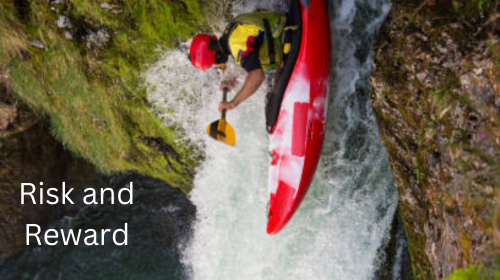
Recognize that the thrill comes with significant risks. Navigating through tumultuous waters demands respect for the force of nature and an unwavering commitment to safety tips.
If you’re considering paddling through the frothing currents of a river, I advise a thoughtful approach to preparation.
Preparation: The Key to a Safe and Successful Adventure

- Familiarize yourself with the sport’s intrinsic hazards: currents, rocks, and unpredictable elements.
- Commit to understanding the necessary skills and techniques that can mean the difference between a heart-pounding adventure and a perilous situation.
- Remember, your safety on the water doesn’t start with just strapping on a life jacket. It begins with a mindset that prioritizes knowledge, preparation, and self-awareness.
Remember, your safety on the water doesn’t start with just strapping on a life jacket. It begins with a mindset that prioritizes knowledge, preparation, and self-awareness.
Remember, your safety on the water doesn’t start with just strapping on a life jacket. It begins with a mindset that prioritizes knowledge, preparation, and self-awareness.
Ask yourself:
Do I know the area I’ll be kayaking in?
Have I checked the weather and water conditions?
Am I prepared to handle emergencies?
In whitewater kayaking, your best defense against danger is a good offense. And by offense, I mean the proactive steps of gathering information, investing in proper training, and ensuring you have the right equipment.
By respecting the power of the rapids and understanding your own limitations, you set the stage for a safe and enjoyable experience.
As we transition to the next section, you’ll see how integral proper gear is to your safety.
I’ll guide you through selecting the right equipment—not just for comfort and performance, but for survival. Because when you’re up against the formidable force of the river, your gear is your first line of defense.
Gearing Up for Safety: Essential Equipment for Whitewater Kayaking
Equipping yourself correctly is critical. It’s not just about comfort; it’s about survival.
The right gear can mean the difference between a minor mishap and a life-threatening situation. So, when you’re compiling your checklist, make sure to include these non-negotiable items. They are as follows:
1. The Basics: Helmet and Life Jacket
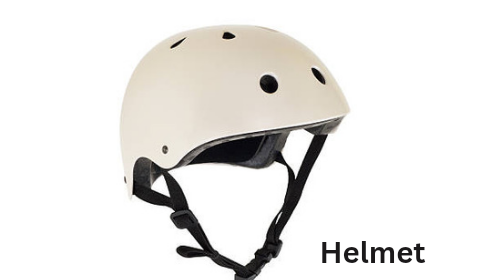
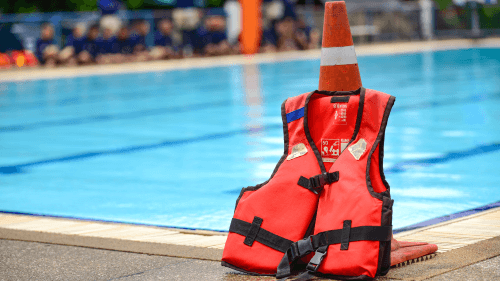
First up, your helmet. I cannot stress this enough, your helmet is your best friend on the rapids. It protects your head not just from falls, but also from flying debris and unforeseen obstacles.
Similarly, a life jacket, or personal flotation device (PFD), isn’t optional. It keeps you afloat during an unexpected swim and can provide essential warmth in cold water conditions.
2. The Kayak: Choose Wisely
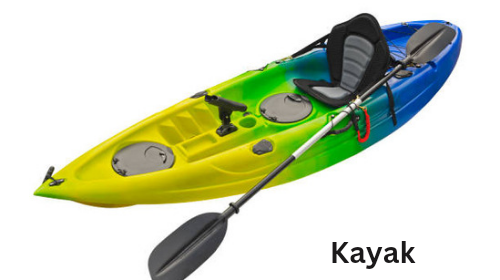
Then there’s the kayak. Choose one that’s designed for whitewater. They have the following essential features:
- Shorter,
- More Robust,
- And Agile, allowing for maneuverability among tumultuous waters. This isn’t the place to skimp or settle for something outside its intended use.
3. The Clothing: Dress for the Occasion
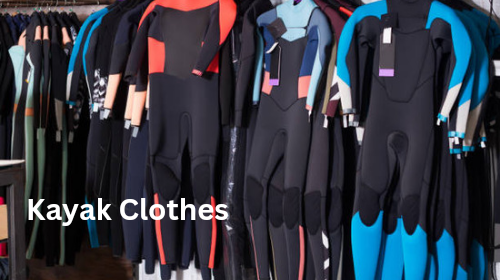
But beyond these basics, you need to suit up properly. Protective clothing is a must.
Depending on the temperature, you may need either of these clothes:
- Dry suit or
- A wetsuit to help maintain your body’s core temperature.
- Durable, snug-fitting footwear designed to keep your feet safe from sharp rocks or slippery surfaces.
4. The Accessories: Don’t Leave Home Without Them
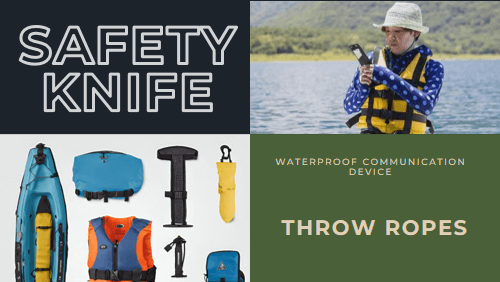
There are also a few safety accessories that can make a significant difference:
- Throw ropes can rescue you or a peer if caught in a current.
- A safety knife is vital for entanglement situations.
- A waterproof communication device ensures you can call for help when you’re out of shouting distance, such as a VHF radio or mobile phone (if you have coverage).
- A whistle can help you communicate with other paddlers or signal for help in case of an emergency
- A bilge comes in handy when you need to get rid of excess water weight that can sink your kayak.
You have your gear; now, hone your skills. Without understanding how to read the river or self-rescue, even the best equipment can fail to protect you.
Let’s discuss how knowledge and preparation are just as important as your safety gear.
Knowledge is Power: Skills and Techniques for Safe Kayaking
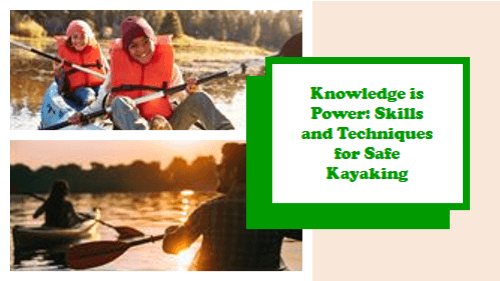
I can’t stress enough how brushing up on your skills and understanding the right techniques can make a monumental difference in whitewater kayaking.
Whether you are someone new to the sport or with rivers’ experience under your belt, continual learning keeps you sharp and prepared.
These are the following Skills you need to learn:
Skill 1. Reading the Water: Spot the Signs
Understanding how to read the water is your first line of defense.
You need to recognize what each Ripple, wave, and whirlpool might mean for your passage. It’s about seeing the signs of what lies beneath the surface that could either be your ally or your threat.
Skill 2. Self-Rescue: Roll with It
Mastering self-rescue techniques shouldn’t be optional. The roll – being able to right your kayak if you’ve tipped over – is not just a cool trick; it’s a lifesaver.
And while we’re on the subject, practicing how to extricate yourself from a capsized kayak is equally vital.
Here’s a video to help you with your practice;
Skill 3. Group Dynamics: Teamwork Makes the Dream Work
Never undermine the power of group dynamics. Kayaking alone is risky, so when you’re with a team, it becomes essential to know effective communication signals and how to work together to navigate the complex waters. After all, safety often comes in numbers.
Skill 4. Learning and Adapting: Stay on Top of Your Game
The river is always changing, which means your strategies and techniques must evolve too.
By attending workshops, joining clubs, or hiring a guide, you can learn the newest and most effective safety practices.
Sure, I can help you with that. Here are some possible subheadings for your blog section post:
Preparing for the Unexpected: Emergency Protocols and First Aid
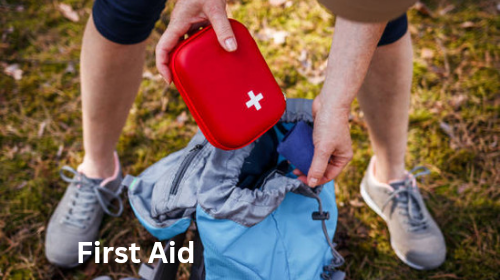
Despite all the careful planning and skill development, whitewater kayaking can sometimes take an unexpected turn.
It’s crucial to have a set of emergency protocols in place to handle such events calmly.
Capsizing: Don’t Panic, Just Roll
If you capsize, remember that the primary rule is to keep your head and not panic.
Proper training will provide you with the techniques for a strategic self-rescue, which can include
- The Eskimo Roll or
- Swimming to safety with your boat.
Injuries: Know How to Treat Them
Knowing how to deal with common injuries related to kayaking can mean the difference between a minor setback and a major emergency. Basic first aid knowledge is essential.
This includes:
- How to manage cuts,
- Bruises,
- Dislocations, or
- Hypothermia, which is a real concern in cold water conditions,
Always pack a well-stocked, waterproof first aid kit and familiarize yourself with its contents before your trip.
Planning: Have a Backup Plan
Emergency preparedness also involves having a well-thought-out plan that includes potential exit points along your route, knowledge of the nearest medical facilities, and ensuring that someone not on the trip knows your plan and expected timeline.
Beyond personal equipment, consider investing in group safety gear such as:
- Throw bags,
- Pin kits, and
- A satellite phone or personal locator beacon for areas where cell service is unreliable.
Adaptability: Be Ready for Anything
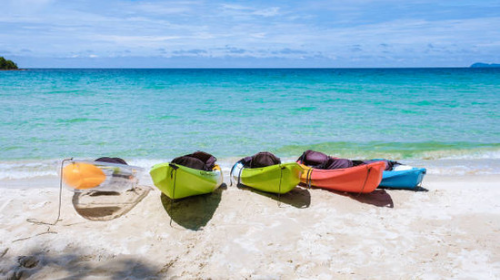
Remember, every trip on the water is different, and there’s always an element of the unknown. Being prepared for emergencies not only keeps you safe but also ensures that you can assist others in need.
Your safety gear, skills, and knowledge are as crucial as your paddle and kayak in the world choosing the right whitewater kayaking is important.
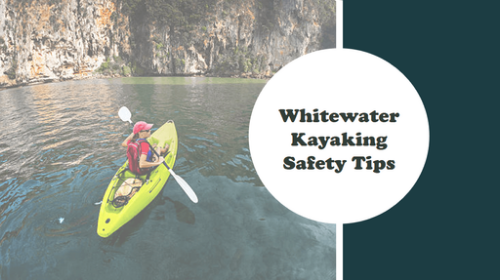
Your article on whitewater kayaking safety is both informative and crucial for anyone venturing into this thrilling activity. I appreciate your emphasis on proper equipment, especially helmets and life jackets. Have you encountered any specific instances where having the right gear made a significant difference in safety outcomes? Personal anecdotes could further drive home the importance of these precautions.
Moreover, your discussion on understanding river classifications and respecting water levels is essential. It’s paramount to assess one’s skill level and the conditions before hitting the rapids. I recall a time when I underestimated the river’s power and got caught in a swift current. It was a wake-up call that underscored the need for caution and respect for nature’s forces. Your insights reaffirm the importance of preparation and vigilance in whitewater kayaking. Thank you for sharing your expertise and promoting safety in this exhilarating sport!
Hi Pasindu,
Thank you for your comment and your interest in whitewater kayaking safety. I’m glad you found my article useful and relevant.
Yes, I have encountered some situations where having the right gear saved me from potential injuries or worse. Whether you are kayaking on a class I or Class IV rapid, there’s a chance that you could hit a rock or make the wrong move that could cause your kayak to flip over or capsize, wearing a helmet or life jacket in this situation can be the difference between you going injury free, or ending up with potentially life-threatening injury, as you’ll get protected from the impact. It could also help you stay afloat until you’re able to roll back up.
Dry Suit is a kayak gear that could prevent you from getting hypothermia if you’re kayaking on a cold river.
These are just some of the examples that show how important it is to have proper equipment when whitewater kayaking.
As you rightly suggested, understanding river classifications and respecting water levels are essential. It’s always good that you always take caution; learning from your experience might be costly, and you should prioritize the need for caution and respect for nature’s forces.
Whitewater kayaking can be a lot of fun, but it can also be very dangerous if you are not prepared and vigilant.
I hope you enjoy your whitewater kayaking adventures and stay safe!
Cheers!